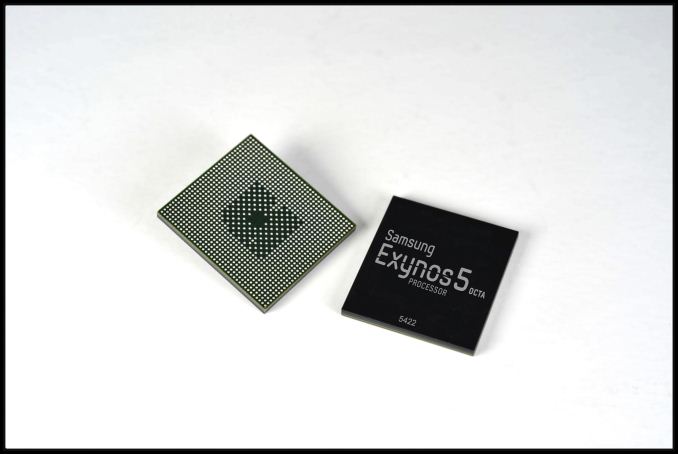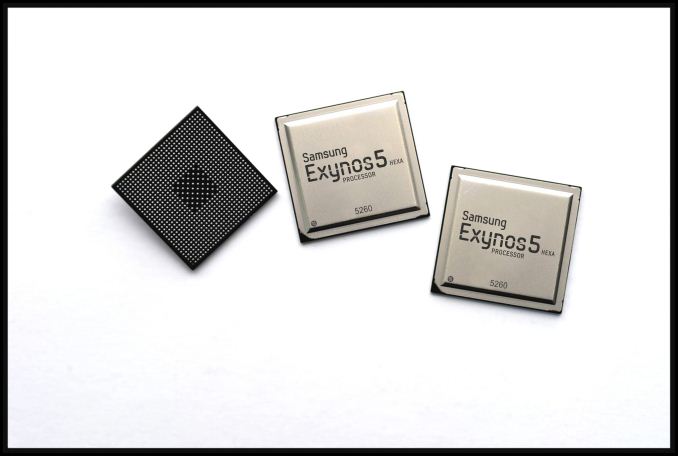Samsung's Exynos 5422 & The Ideal big.LITTLE: Exynos 5 Hexa (5260)
by Anand Lal Shimpi on February 25, 2014 9:00 PM EST- Posted in
- SoCs
- Samsung
- Smartphones
- Mobile
- Tablets
- exynos 5 octa
- Exynos 5 Hexa

Samsung announced two new mobile SoCs at MWC today. The first is an update to the Exynos 5 Octa with the new Exynos 5422. The 5422 is a mild update to the 5420, which was found in some international variants of the Galaxy Note 3. The new SoC is still built on a 28nm process at Samsung, but enjoys much higher frequencies on both the Cortex A7 and A15 clusters. The two clusters can run their cores at up to 1.5GHz and 2.1GHz, respectively.
The 5422 supports HMP (Heterogeneous Multi-Processing), and Samsung LSI tells us that unlike the 5420 we may actually see this one used with HMP enabled. HMP refers to the ability for the OS to use and schedule threads on all 8 cores at the same time, putting those threads with low performance requirements on the little cores and high performance threads on the big cores.
The GPU is still the same ARM Mali-T628 MP6 from the 5420, running at the same frequency. Samsung does expect the 5422 to ship with updated software (drivers perhaps?) that will improve GPU performance over the 5420.
| Exynos 5 Comparison | ||||||||
| SoC | 5250 | 5260 | 5410 | 5420 | 5422 | |||
| Max Number of Active Cores | 2 | 6 | 4 | 4 (?) | 8 | |||
| CPU Configuration | 2 x Cortex A15 | 2 x Cortex A15 + 4 x Cortex A7 | 4 x Cortex A15 + 4 x Cortex A7 | 4 x Cortex A15 + 4 x Cortex A7 | 4 x Cortex A15 + 4 x Cortex A7 | |||
| A15 Max Clock | 1.7 GHz | 1.7GHz | 1.6GHz | 1.8GHz | 2.1GHz | |||
| A7 Max Clock | - | 1.3GHz | 1.2GHz | 1.3GHz | 1.5GHz | |||
| GPU | ARM Mali-T604 MP4 | ARM Mali-T624 (?) | Imagination PowerVR SGX544MP3 | ARM Mali-T628 MP6 | ARM Mali-T628 MP6 | |||
| Memory Interface | 2 x 32-bit LPDDR3-1600 | 2 x 32-bit LPDDR3-1600 (?) | 2 x 32-bit LPDDR3-1600 | 2 x 32-bit LPDDR3-1866 | 2 x 32-bit LPDDR3-1866 | |||
| Process | 32nm HK+MG | 28nm HK+MG (?) | 28nm HK+MG | 28nm HK+MG | 28nm HK+MG | |||
The launch vehicle for the 5422 is likely the recently announced Galaxy S 5. Although most of what we'll encounter will ship with Qualcomm's Snapdragon 801, we'll likely see some international variants with the 5422. It's also entirely possible that some future Exynos 5422 SGS5 variants will feature an Intel XMM 7160 LTE modem.
The more exciting news however is the new Exynos 5 Hexa, a six-core big.LITTLE HMP SoC. With a design that would make Peter Greenhalgh proud, the Exynos 5260 features two ARM Cortex A15 cores running at up to 1.7GHz and four Cortex A7 cores running at up to 1.3GHz. The result is a six core design that is likely the best balance of performance and low power consumption. HMP is fully supported so a device with the proper scheduler and OS support would be able to use all 6 cores at the same time.
The 5260 feels like the ideal big.LITTLE implemention. I'm not expecting to find the 5260 in many devices, but I absolutely want to test a platform with one in it. If there was ever a real way to evaluate the impact of big.LITTLE, it's Samsung's Exynos 5260.
Samsung didn't announce cache sizes, process node or GPU IP for the 5260. Earlier leaks hinted at an ARM Mali T624 GPU. Samsung's release quotes up to 12.8GB/s of memory bandwidth, which implies a 64-bit wide LPDDR3-1600 interface.











35 Comments
View All Comments
porphyr - Tuesday, February 25, 2014 - link
I'm really happy that we have a 2 big/4LITTLE configuration around now. Hopefully someone gets an implementation into your handsArmanUV - Wednesday, February 26, 2014 - link
Could someone explain why Samsung is still using Qualcomm SoCs for their LTE-enabled devices? Surely Samsung could have produced their own LTE compatible Exynos SoC by now, no?aryonoco - Wednesday, February 26, 2014 - link
Exynos is LTE compatible. There are many variants of SGS4 and Note 3 with Exynos and LTE. It's just that in certain markets (US, Canada, Australia) carriers are very picky and require a lot of testing and validation of new platforms. Qualcomm already does that heavy lifting with its SoCs so if you use a Qualcomm platform you can skip a lot of that grunt work whereas if Samsung wanted to use its own SoC, that would require a lengthy and time-consuming validation and testing process with these carriers and time to market is very important in this industry.lilmoe - Friday, February 28, 2014 - link
+1I would like to add to that one point. Samsung, like any other OEM, is a business first and last. They'll go with whatever is profitable, especially since Qualcomm's are very popular (and reliable) ATM.
darkich - Wednesday, February 26, 2014 - link
Yeah I agree that 2+4 is probably the best combination.. 4 A7's at up to 2 GHz and 2 A15's(r3p3) at 2.1GHz would be better than the 8 core Exynos 5422 imo.darkich - Wednesday, February 26, 2014 - link
The dream SoC, as I see it:4 A53 cores at up to ~2 GHz, 2 A57 cores at up to~3GHz, Maxwell ULP GPU, all done on 14 - 16 nm.
darkich - Wednesday, February 26, 2014 - link
Anand, here's a test of the Note 3 Neo with the Exynos Hexa:http://www.gsmarena.com/samsung_galaxy_note_3_neo-...
The chip doesn't seem to beat the Snapdragon 800, on contrary actually.
darkich - Wednesday, February 26, 2014 - link
..beat it efficiency-wise, that is.Jon Tseng - Thursday, February 27, 2014 - link
5422 HMP sounds a bit pointless: Do they really think you're going to be able to run 8 cores simultaneously in thought thermal evelope? Sounds unlikely to me!Wilco1 - Thursday, February 27, 2014 - link
HMP doesn't imply that all 8 cores must be running simultaneously, or at their maximum frequency. HMP means that if you say have 1 high performance task and 3 low performance tasks, it may use 3 little cores and 1 big core. Without HMP you'd be forced to use 2 or 3 big cores, which is less efficient.